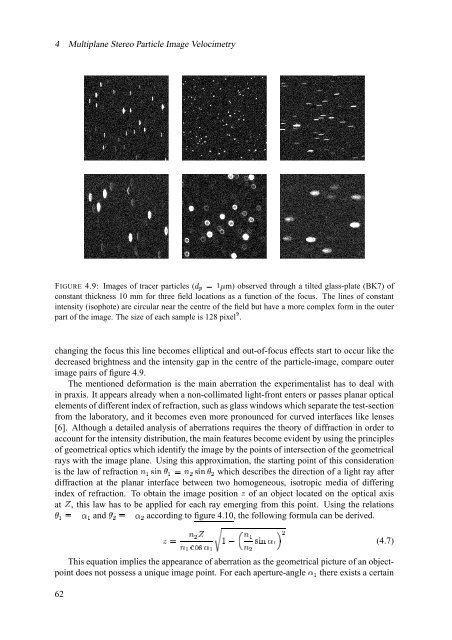The significance of coherent flow structures for the turbulent mixing ...
The significance of coherent flow structures for the turbulent mixing ...
The significance of coherent flow structures for the turbulent mixing ...
You also want an ePaper? Increase the reach of your titles
YUMPU automatically turns print PDFs into web optimized ePapers that Google loves.
n<br />
è<br />
h<br />
¤<br />
î<br />
4 Multiplane Stereo Particle Image Velocimetry<br />
FIGURE 4.9: Images <strong>of</strong> tracer particles (¢ ›£¤ m) observed through a tilted glass-plate (BK7) <strong>of</strong><br />
constant thickness 10 mm <strong>for</strong> three field locations as a function <strong>of</strong> <strong>the</strong> focus. <strong>The</strong> lines <strong>of</strong> constant<br />
intensity (isophote) are circular near <strong>the</strong> centre <strong>of</strong> <strong>the</strong> field but have a more complex <strong>for</strong>m in <strong>the</strong> outer<br />
part <strong>of</strong> <strong>the</strong> image. <strong>The</strong> size <strong>of</strong> each sample is 128 pixelî .<br />
changing <strong>the</strong> focus this line becomes elliptical and out-<strong>of</strong>-focus effects start to occur like <strong>the</strong><br />
decreased brightness and <strong>the</strong> intensity gap in <strong>the</strong> centre <strong>of</strong> <strong>the</strong> particle-image, compare outer<br />
image pairs <strong>of</strong> figure 4.9.<br />
<strong>The</strong> mentioned de<strong>for</strong>mation is <strong>the</strong> main aberration <strong>the</strong> experimentalist has to deal with<br />
in praxis. It appears already when a non-collimated light-front enters or passes planar optical<br />
elements <strong>of</strong> different index <strong>of</strong> refraction, such as glass windows which separate <strong>the</strong> test-section<br />
from <strong>the</strong> laboratory, and it becomes even more pronounced <strong>for</strong> curved interfaces like lenses<br />
[6]. Although a detailed analysis <strong>of</strong> aberrations requires <strong>the</strong> <strong>the</strong>ory <strong>of</strong> diffraction in order to<br />
account <strong>for</strong> <strong>the</strong> intensity distribution, <strong>the</strong> main features become evident by using <strong>the</strong> principles<br />
<strong>of</strong> geometrical optics which identify <strong>the</strong> image by <strong>the</strong> points <strong>of</strong> intersection <strong>of</strong> <strong>the</strong> geometrical<br />
rays with <strong>the</strong> image plane. Using this approximation, <strong>the</strong> starting point <strong>of</strong> this consideration<br />
is <strong>the</strong> law <strong>of</strong> refraction ZCç]ê|ë2¥]¦ŽçÙèsZmîgê|ë2¥§¦0î<br />
which describes <strong>the</strong> direction <strong>of</strong> a light ray after<br />
diffraction at <strong>the</strong> planar interface between two homogeneous, isotropic media <strong>of</strong> differing<br />
index <strong>of</strong> refraction. To obtain <strong>the</strong> image position n <strong>of</strong> an object located on <strong>the</strong> optical axis<br />
at ¨ , this law has to be applied <strong>for</strong> each ray emerging from this point. Using <strong>the</strong> relations<br />
¦Žç è©«ª ç and ¦0î è¬]ªCî according to figure 4.10, <strong>the</strong> following <strong>for</strong>mula can be derived.<br />
Zmî ¨<br />
(4.7)<br />
Z¡î<br />
ZC祯®êoª
















